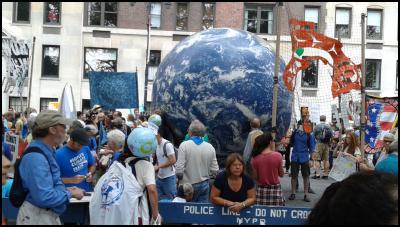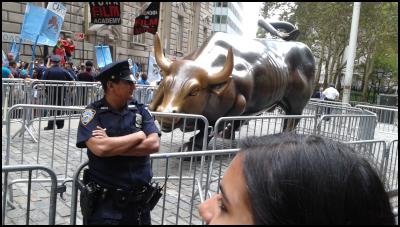Climate march and Flood Wall Street - from NYC
Climate march and Flood Wall Street - from
NYC
By Richard McLachlan24 September 2014

This oddly mild New York summer may have helped create the impression that predicted changes to the climate are no longer such a big deal – and the world seems to be burning in so many other alarming ways. This Sunday 21st September, day of the New York (and world-wide) Peoples Climate March, saw Secretary of State John Kerry give climate change major prominence alongside ISIS and Ebola, quite a move for a country on a war footing with both. On that same day the Rockefeller family, founders of Standard Oil, undertook to divest their $860 million philanthropic arm of its fossil fuel portfolio.
The far from crowded Sunday morning Q train into Manhattan is heavy with ads for the march. The now-familiar half submerged Statue of Liberty is there yet again – a visual meme for catastrophic climate change. ‘To Change Everything, We Need Everyone’ jumps out in huge letters, competing with carriage-length coverage of the coming TV show, ‘How To Get Away with Murder’.
I notice my apprehension over just how many people will come to the ‘biggest climate march in history’. Attendance really matters, with around 125 heads of state from all over the world (barring those of China, India, Russia - and Australia) attending a climate summit beginning on Tuesday. The Secretary-General Ban Ki Moon says he will be there, that he will “link arms with those marching for climate action”.
As we walk from the subway station toward Central Park, the streets around West 69th street are no more crowded than usual. Small clumps of people are gathered here and there in the park. There are 29 marching bands. Five hundred buses have come from all over the US, and the city has closed down 26 blocks of Manhattan to accommodate it all - including a full size and very realistic polar bear inhabited by a pink-faced, sweaty young man who emerges periodically for a spot of fresh air.
The march, when it gets going, is enormous – 310 thousand is a vast river of people stretched out along Central Park West. In this city of parades, where the Macys or Gay Pride parades make it impossible to move in large sections of Manhattan because the pavements are so full of spectators, there are very few watching – they are all marching.
The march has a beat, led by bass and snare drums, trumpets and trombones – accompanied by threshing helicopter rotors overhead. Then complete silence as three hundred thousand people commemorate those who have already died as a result of climate change. Then, over the talking and the laughing and the marching bands, you can hear the sound of a far distant cheer growing closer and then almost deafeningly loud, a pulse of human urgency passing from the back of the procession to the front.
There are very few police in evidence, no sense of impending disorder, no angry counter-demonstrations – just many, many humans whose concerns, some very specific indeed, all fit comfortably within a Peoples’ Climate March.
Monday following the march, the day of ‘Flood Wall Street’, is a different story altogether. Here is the convergence or, to pursue the day’s water metaphor, the confluence of Occupy Wall Street and 350.org, the organization dedicated to containing global temperatures. From an initial training meeting in Battery Park, more than two thousand people marched to the famous Wall Street bull on Broadway. Surging around the stranded double-decker tourist buses, their occupants denied for a day the famous opportunity to rub the bull’s shiny bronze testicles, the protesters occupied the space with bodies, chants, a great brass band, huge inflatable ‘carbon bubbles’, and a 300 foot banner. Three helicopters hung like enormous dragonflies motionless in formation in the sky over the financial district.
The police had the crowd well contained, ensuring there was no access to the actual Wall Street, that financial engine driving so much of the looming catastrophe – only its symbol, the bronze bull (there is no bear). Both the buildings either side of lower Broadway and the mass of police vehicles and uniformed staff either end, allowed for a crowd control strategy known as ‘kettling,’ gradually containing and compressing the band of protesters, who sat down in a circle on the pavement between Wall Street and Trinity Church.
The protocols of the Occupy movement were also in evidence with the human mike being used to amplify messages across two city blocks. No need for bullhorns here. Occupy has an interesting presence in New York City. Hurricane Sandy in October 2012 saw the Occupy movement in action the following morning. During the hurricane they had been organizing on social media – the next day they were distributing food and clothing from makeshift centers out on the Rockaway Peninsula.
Connecting the dots of the greater malaise, they moved after Sandy to enter the ‘distressed debt’ market, buying and then forgiving millions of dollars worth of distressed health and student loan debt as part of the Rolling Jubilee movement. Yesterday they were back again, organizing to challenge the excesses, if not the very existence, of Wall Street.
Growing disquiet about the climate has been running in parallel to widespread anger at economic inequity, especially here in the US. This inequity has found a cultural meme in Occupy’s rhetoric of the ninety-nine versus the one percent – it’s in evidence everywhere. Yesterday morning National Public Radio featured a young Hispanic man talking about his family’s life below the official poverty level. He described having to look after his infant siblings instead of attending school, and deciding he had to stop that and attend classes, or end up in the same position as his parents. Later the same day, prior to getting arrested for continuing to flood Wall Street, my wife Liza heard a man in a sharp suit describing to a friend outside the Stock Exchange how he ‘makes’ $29,000 a day! It’s true. It really happened. Sometimes living here is like inhabiting a comic book.
Naomi Klein’s just released book ‘This Changes Everything’ links the behaviour of capitalist elites and their support of climate change denial to global warming and points to the need for radical change to our core economic arrangements. In apparent agreement, the political far right in the US is accusing the climate movement of being ‘watermelons’: green on the outside, red in the middle – a cover for a resurgence of socialism and an anti–free market, anti-big business, pro-tax agenda.
Whatever the movement’s agenda, the question of who pays for the damage from climate events has yet to assert itself in the public debate. The New York subway’s R train is back in service after extensive, publicly funded, post-hurricane repairs to its tunnel. So far, some of the largest impacts of climate change around here have been a cost on the public purse. How long that continues uncontested, with planned and very costly climate change mitigation infrastructure expenses in the offing, remains an open question.
It’s not just the climate that’s heating up. Corporate America is not unified on this issue. Today Google publicly withdrew from its association with the climate science-denying lobby group, the American Legislative Exchange Council (ALEC). Google’s CEO Eric Schmidt said ALEC has been “literally lying” about the reality of climate change and that Google no longer wants to be associated with that sort of thing. Microsoft made the same move in August. Let’s hope this, and the Rockefeller decision, was some small consolation to the poor, overheated polar bear as he held out his paws to the plastic handcuffs of the irony-free NYPD yesterday evening.


http://thehoytreport.wordpress.com/


 Dee Ninis, The Conversation: Why Vanuatu Should Brace For Even More Aftershocks After This Week’s Deadly Quakes: A Seismologist Explains
Dee Ninis, The Conversation: Why Vanuatu Should Brace For Even More Aftershocks After This Week’s Deadly Quakes: A Seismologist Explains Martin LeFevre - Meditations: Meditation Without A Method
Martin LeFevre - Meditations: Meditation Without A Method Ramzy Baroud: Israel To Annex The West Bank – Why Now? And What Are The Likely Scenarios?
Ramzy Baroud: Israel To Annex The West Bank – Why Now? And What Are The Likely Scenarios? Binoy Kampmark: The Strawman Of Antisemitism - Banning Protests Against Israel Down Under
Binoy Kampmark: The Strawman Of Antisemitism - Banning Protests Against Israel Down Under Gordon Campbell: On The Coalition’s Empty Gestures, And Abortion Refusal As The New Slavery
Gordon Campbell: On The Coalition’s Empty Gestures, And Abortion Refusal As The New Slavery Keith Rankin: Judaism, Antisemitism, And Israel
Keith Rankin: Judaism, Antisemitism, And Israel